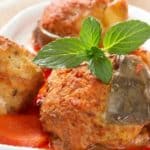WHY I LOVE THIS RECIPE: It was not love at first sight. In fact, my grandmother forced me to eat gefilte fish when I was five year old, and I did not like it! But as with many things, the food became part of my life, my childhood, and my experiences, and as such it became something I fondly remember and miss. My grandmother’s recipe was not easy to reproduce, because although I do have a written version, there was much improvisation, and just like life, the recipe changed a little bit each time she made it. In fact, my life stories, as I reflect on my family and the times we shared, parallel my grandmother’s gefilte fish recipe. When I grew up I did a little of everything, whatever was needed to help the family survive while keeping up with my studies and building for a future. As an adult I worked a little here and a little there, whatever it took which was just like my grandmother’s recipe – a pinch of this and a pinch of that, whatever it took to make it perfect. Sometimes she used a pinch of salt and a little more garlic or pepper, or a little less lemon or onion, depending on the taste at the time. It was always changing a little bit, and just like life, each batch came with its own challenges requiring the necessary adjustments and changes, but making it was always fun and enjoyable, and the end result was divine.
Gefilte Fish
Ingredients
- 3 lbs cooked fish (pike and carp or pike and whitefish)
- 2 large onions, sliced
- 2 eggs
- 1/4 cup matzoh meal or breadcrumbs
- 1 tsp salt, plus salt for flesh and bones
- 1/8 tsp pepper
- 2 Tbsp cold water, plus water to cover
- 1 stalk celery, diced
- 1 large carrot, sliced
- 1 Tbsp parsley. chopped
- prepared horseradish
Instructions
- Cut fish into 2-inch slices. Carefully remove flesh and bones without
breaking skins. Salt the skins and bones and place in a covered bowl
in refrigerator while preparing filling. - Put the flesh and 1 onion through a food chopper, then place in a wooden
chopping bowl and cut until smooth. Add eggs, matzo meal or
breadcrumbs, 1 teaspoon salt, pepper to taste, and enough cold water
to make a light soft mixture. Blend thoroughly. - Wet hands with cold water. Form oval cakes of mixture and fit them into skins. Place head bones and any other bones in the bottom of a deep heavy kettle. Add oval cakes of fish in skins on top. Add remaining onion, celery, carrot, and cold water to cover. Cover kettle and bring to a quick boil. Remove cover. Reduce heat and cook at avery slow boil 1 1/2 to 2 hours. The liquid should be reduced by half. Allow to cool slightly before removing fish to a platter carefully so as to retain shape.
- Serve warm or thoroughly chilled, garnished with sliced, cooked carrot and chopped parsley. If served cold, use the jellied sauce as a garnish. Serve with prepared horseradish.
Notes
Two slices of white bread may be substituted for matzo meal or breadcrumbs. Soak the bread in cold water and squeeze out. If bread is used it may not be necessary to moisten the chopped fish mixture with cold water. One raw carrot may be grated and added to fish mixture. Balls: Shape the prepared fish mixture into balls. Place the skin and bones in the bottom of kettle before adding vegetables and fish balls. Cook as in basic recipe. Whole: Do not section the fish. Fillet the fish, being careful not to break skin and to leave head and tail intact. Prepare filling as in basic recipe. Fill the whole skins with this mixture, shaping to look natural. Use a deep, oval pot and place the fish on a trivet over the vegetables in the pot. Cover with cold water and bring slowly to boiling point. Cook at a slow boil for 1 1/2 to 2 hours. Baked gefilte fish: Prepare as in basic recipe. If stuffed whole, place in well-greased baking pan. Sprinkle with breadcrumbs. Dot with butter. Bake in hot oven.
The Tracing Roots & Building Trees project paired teens from Tucson Hebrew High with residents of Handmaker Jewish Services for the Aging to remember stories and favorite foods together. From this experience a cookbook, “L’dor v’dor: From Generation to Generation: Stories and Memories around Family and Food, was published.


Leave a Reply